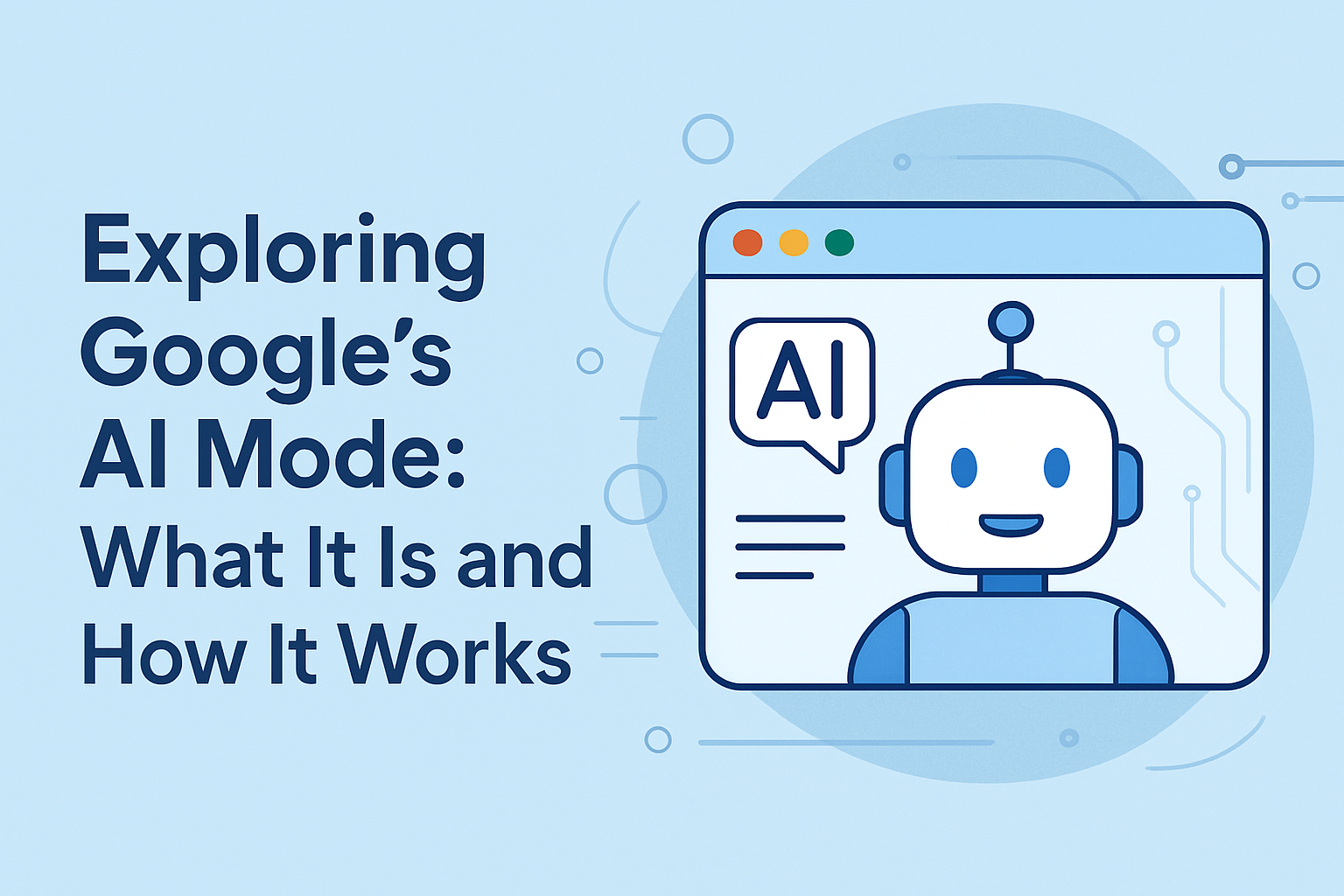Let’s start with some amazing facts regarding Google’s AI Mode: What It Is and How It Works
AI is transforming how we use technology and how firms do business. One of the most important businesses in AI is Google. It has produced cutting-edge AI models that are used in everything from search engines to tools for making art. One of the newest things in this field is Google’s AI mode. It illustrates how dedicated the company is to making AI simple to use, useful, and incredibly strong.
What is the name of Google’s AI mode, how does it work, and how is it different from other AI systems like Gemini? This blog post goes into a lot of information regarding Google AI models, what they can achieve, and how they can be used in different ways. By the end, you’ll know how to use Google AI, why it’s crucial in the IT industry today, and how it stacks up against alternative choices.
What Is Google AI?
It’s important to go over the basics before you start using Google AI. What does Google AI mean? Google AI mod is all about the tools, methods, and services that Google has made to make computers smarter. Google AI is the basis for many new products and services, from language models to machine learning platforms. Understanding how it works can be as crucial as comparing programming languages like Java vs. Kotlin for developers looking to build smarter applications.
Google’s AI is meant to solve a wide range of problems, from recognizing images to helping self-driving automobiles. The company’s newest versions, like Google AI mode, are pushing the limits of machine learning, and they are always coming up with new ideas for their technology.
What AI Does Google Use?
Google’s success is based on TensorFlow, an open-source machine learning framework, and other cutting-edge tools. With TensorFlow, you can build neural networks that work like the brain. Because of this, Google has made very advanced AI systems like BERT (Bidirectional Encoder Representations from Transformers) and PaLM (Pathways Language Model).
These models are the building blocks of Google’s AI ecosystem. They make it possible for the corporation to come up with new ideas in many areas, including search, translation, and natural language processing.
What Is Google AI Mode?
Improve the performance of Google goods and services with the help of Google AI mode, a sophisticated framework developed within the Google ecosystem. AI mode is a feature that takes context into account and aims to enhance search experiences, streamline tasks, and streamline processes. Integrated into Google’s primary offerings, such as Search, Workspace, and Assistant, it streamlines processes and saves time.
Google AI mode uses contextual clues and the user’s intent to provide accurate and personalized results. By learning about a user’s tastes and actions, AI mode search on Google, for instance, returns better results.
Key Google AI Features
Some standout features of Google AI mode include
- Contextual Intelligence
AI mode adapts to the context of the task, whether it’s refining a search term or improving a document in Google Docs.
- Natural Language Processing (NLP)
Using NLP models like BERT, AI mode enables Google tools to interpret and respond to human language seamlessly.
- Real-Time Recommendations
From suggesting the next word while typing to offering quick navigation options in Maps, Google AI mode anticipates user needs.
- Enhanced Search Power
Through Google AI mode search, users can retrieve precise answers with minimal effort, avoiding irrelevant or redundant results.
- Creative Assistance
Google’s efforts in generative AI include creating tools to spark creativity, such as using AI-powered design recommendations in Google Slides.
Advantages of Google AI Mode
- Faster Decision-Making: With contextual awareness, Google AI cuts down the time needed to find answers.
- Improved Accuracy: The learning models account for nuances like tone, location, and context, delivering highly accurate results.
- Ease of Accessibility: Whether you’re a student, researcher, or casual user, it’s easy to use Google AI across multiple platforms without a steep learning curve.
New Google AI Advancements and Their Applications
Google’s most recent strides in AI solidify its status as a trailblazer in artificial intelligence. The introduction of new Google AI models is transforming traditional workflows in various fields.
AI in Everyday Productivity Tools
Google Workspace integrates AI to improve user productivity. For instance:
- Gmail now uses AI to flag important emails and suggest replies.
- Google Docs leverages machine learning to automatically correct grammar and spelling mistakes.
- Slides uses AI for design optimization and layout suggestions.
Revolutionizing Search with AI
Search has long been Google’s crown jewel, and AI plays a vital role in its transformation. Google AI mode search essentially “understands” queries—and not just their literal meaning but also the user’s intent.
For example:
- Searching “good Thai food near me” in AI-enabled mode will take into account your location and even past dining preferences to suggest the best restaurants.
AI and Creativity
Google AI is not just making technical work easier, but it is also inspiring innovation. Google Bard is an AI chatbot that helps people come up with creative ideas. Machine-learning models help writers and designers create material or make visual designs.
AI in Data and Analytics
Companies can now count on Google’s AI tools to swiftly and accurately look at huge amounts of data. This makes sure that judgments are based on data with little work.
How Does Google AI Work?
One of the most important things about Google AI is that it can keep learning and getting better. Google AI models use complicated training datasets to find trends, improve accuracy, and come up with new ideas. These models have been curated and optimized for years, which makes them some of the best AI tools accessible right now.
Google AI Mode vs. Gemini
You can’t talk about Google AI without also talking about Gemini, which is a competitor AI model made by OpenAI. Both platforms have generative AI, advanced neural networks, and the ability to process natural language.
Key Differences
- Contextual Awareness
Google AI mode puts user-centered and contextual features at the top of its list of priorities. Gemini is strong, yet it often works on its own and needs other applications to work with it.
- Applications
Google AI is a very flexible option because it works well with all of Google’s technologies, such as Chrome, Gmail, and Drive. Gemini, on the other hand, is great at certain things, like making creative content, but it doesn’t have the same range as Google.
- Interoperability
Gemini can work with other apps, but it needs partnerships to reach more people. On the other hand, Google AI mode works natively in an ecosystem that millions of people already use.
- Training Data
Google has a huge collection of proprietary data that it has gathered over the years from its search engine, Maps, and YouTube, among other platforms. This makes its AI much better than that of competitors like Gemini.
The Verdict
While Gemini is a powerful tool, Google AI mode outshines it in versatility and user-friendly implementation.
Final Thoughts on Google AI Models
Google is still shaping the future of AI by making tools and technology that are a big part of our everyday lives. Google AI features are raising the bar for the AI community in many ways, from improving search algorithms to making creative work more productive.
If you like technology or just use the internet from time to time, you may use Google AI mode and its new updates without any problems. The firm promises a future where technology will be even more useful, intuitive, and necessary because of its constant improvements and context-based solutions like Google AI mode.
The best thing about Google is that it can change things quickly. The fight between Google AI mode and Gemini shows how powerful Google is by giving users tools that are not only smart but also trustworthy and work well together.
AI is only getting more powerful, and Google’s progress shows that the future of AI is full of potential. Watch out for what’s coming next; it’s sure to change how we live, work, and come up with new ideas.

